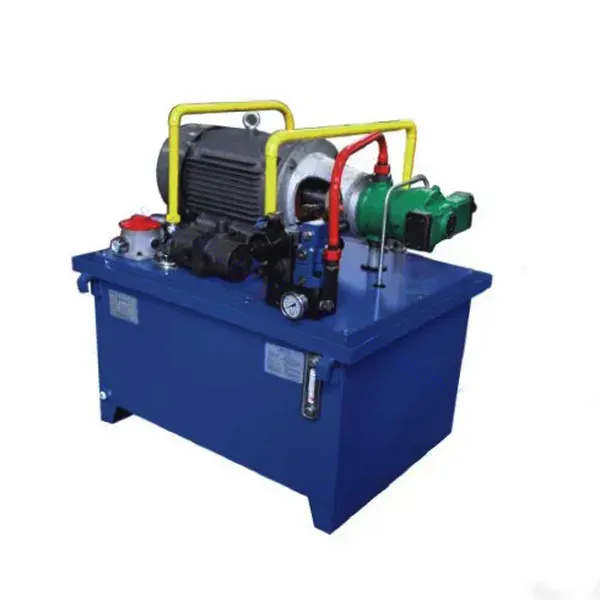Hydraulic System For Coating Equipment
Hydraulic System For Coating Equipment

The hydraulic system for coating equipment is a state-of-the-art solution designed to revolutionize the painting process in various industries. This advanced system offers superior efficiency, precise control, and increased productivity, ensuring optimal performance and superior coating results. Let’s discuss the main characteristics, use methods, maintenance requirements, and other essential aspects of the hydraulic system of painting equipment.
The synchronous hydraulic system controls multiple cylinders to act simultaneously and requires a certain precision. Synchronizing steps or synchronizing valves maintain synchronization accuracy.
Hydraulic System For Coating Equipment Features:
1. The variable piston pump is used with the return oil and water cooler, significantly reducing the system’s heat output.
2. Adopt the best domestic manufacturer synchronous valve to achieve multi-cylinder synchronization and improve production efficiency and accuracy.
3. The use of laser cutting and bending processes to ensure the strength and beauty of the equipment.
Synchronous Hydraulic System Parameter:

Motor Power:11KW
Oil Tank:200L
Custom Hydraulic System Model Description:

Structure Of Oil Tank:

Oil Tank Cleaning Cap:

Custom Hydraulic System:
(1)Vertical Hydraulic System

(2)Horizontal Hydraulic System

(3)Side Mounting Hydraulic System
The side mounting hydraulic pump station, that is, the oil pump device, is horizontally installed based on a separate tank, and the side type can be equipped with a spare pump, which is mainly used for the system with a large mailbox capacity of 250 liters and an electric power of 7.5KW or more.


Characteristics of the Explosion-Proof Hydraulic System For Mine Equipment:
- High Precision and Control
- The hydraulic system controls key coating parameters such as pressure, flow rate, and spray pattern for a consistent and uniform coating.
- Allows fine-tuning of coating parameters during application, ensuring accurate results and reducing waste.
- Versatility and Adaptability
- The system is compatible with a wide range of painting equipment, including spray guns, robotic arms, and automatic painting lines, for various painting applications.
- Provides flexibility to adjust coating parameters to suit different coating materials, substrates, and desired finishes.
- Excellent Efficiency and Productivity
- Minimize over-spraying, reduce material waste, and optimize coating efficiency by providing consistent pressure and flow control.
- Achieve faster coating cycles and increase productivity and throughput without compromising quality.
- User-friendly Interface
- Operators can easily adjust and monitor coating parameters with an intuitive and easy-to-use control interface.
- Provides real-time feedback on pressure, flow, and other critical parameters for precise control and troubleshooting.
What Are The Basic Components Of A Hydraulic System?
A hydraulic system comprises several essential components that generate, control, and transmit hydraulic power. The basic components of a hydraulic system include:
- Hydraulic Fluid:
Hydraulic fluid serves as the medium for transmitting power in the system. It is typically a specially formulated oil with high viscosity, good lubrication, and resistance to foaming and temperature changes. - Reservoir:
The reservoir, also known as the hydraulic tank, holds the hydraulic fluid. It provides a storage location for the fluid, allows for heat dissipation, and facilitates the removal of air and contaminants from the system. The reservoir has a pause to maintain fluid cleanliness and prevent pressure buildup. - Hydraulic Pump:
The hydraulic pump generates flow and pressure in the hydraulic system. It converts mechanical energy into hydraulic energy, typically from an electric motor or an engine. Common types of pumps include gear, vane, and piston pumps. - Actuators:
Actuators are hydraulic devices that convert hydraulic pressure into mechanical force or motion. They are responsible for performing the desired work in the system. The two primary types of actuators are:- Hydraulic Cylinders: Hydraulic cylinders consist of a cylindrical barrel, a piston, and a rod. When pressurized fluid enters the cylinder, it pushes the piston, which generates linear motion. Hydraulic cylinders are commonly used in applications that require straight-line force, such as lifting or pushing.
- Hydraulic Motors: Hydraulic motors convert hydraulic energy into rotational motion. They are often used in applications that require continuous rotary motion, such as driving conveyor belts or rotating machinery.
- Control Valves:
Control valves regulate the flow and pressure of hydraulic fluid in the system. They direct the liquid to the desired actuators and control their speed, direction, and force. Control valves include various types, such as directional control valves, pressure control valves, flow control valves, and proportional valves. - Hydraulic Lines and Hoses:
Hydraulic lines and hoses transport the pressurized hydraulic fluid between the components of the system. They are typically made of steel or flexible materials, such as reinforced rubber or thermoplastic, to withstand high pressures and accommodate system movements. - Filters:
Filters are crucial components that help maintain the cleanliness of the hydraulic fluid. They remove contaminants, such as particles, debris, and water, to prevent damage to system components. Filters are commonly located in the reservoir, suction lines, and return lines. - Accumulator:
An accumulator stores hydraulic energy in the form of pressurized fluid. It consists of a gas-filled chamber separated from the hydraulic fluid by a piston or bladder. Accumulators can absorb pressure surges, store energy for peak demands, and provide emergency power in case of pump failure.
工厂的能力和产能:
(1) 装配
我们拥有一流的自主研发装配平台。液压油缸生产车间拥有 4 条半自动提升油缸装配线和 1 条全自动倾斜油缸装配线,设计年生产能力 100 万支。特种油缸车间配备了各种规格的半自动清洗装配系统,设计年生产能力 20 万只,并配备了知名数控加工设备、加工中心、高精度油缸加工专用设备、机器人焊接机、自动清洗机、油缸自动装配机、自动喷漆生产线等。现有关键设备 300 多台(套)。设备资源的优化配置和高效利用,保证了产品的精度要求,满足了产品的高质量需求。


(2) 机加工
加工车间配备了定制的斜轨车削中心、加工中心、高速珩磨机、焊接机器人及其他相关设备,可加工最大内径 400 毫米、最大长度 6 米的气缸管。

(3) 焊接

(4) 油漆和涂料
配备中小型圆筒自动水性漆喷涂线,实现机器人自动上下料和自动喷涂,设计产能为每班 4000 件;
我们还拥有一条由动力链驱动的大型油缸半自动喷漆生产线,设计产能为每班 60 箱。


(5) 测试
我们拥有一流的检验设施和试验台,确保气缸的性能符合要求。

We are one of the best hydraulic system manufacturers. We can offer comprehensive hydraulic system. We also provide corresponding 农用齿轮箱. We have exported our products to clients worldwide and earned a good reputation because of our superior product quality and after-sales service. We welcome customers at home and abroad to contact us to negotiate business, exchange information, and 与我们合作!
参观我们的 VR 工厂
通过以下方式参观我们的 VR 工厂
液压缸应用:


